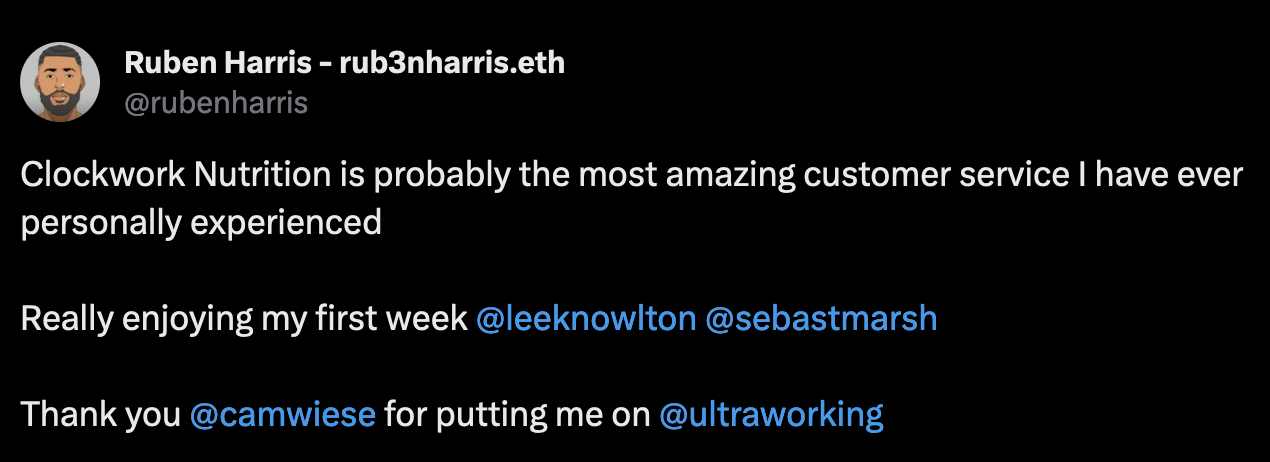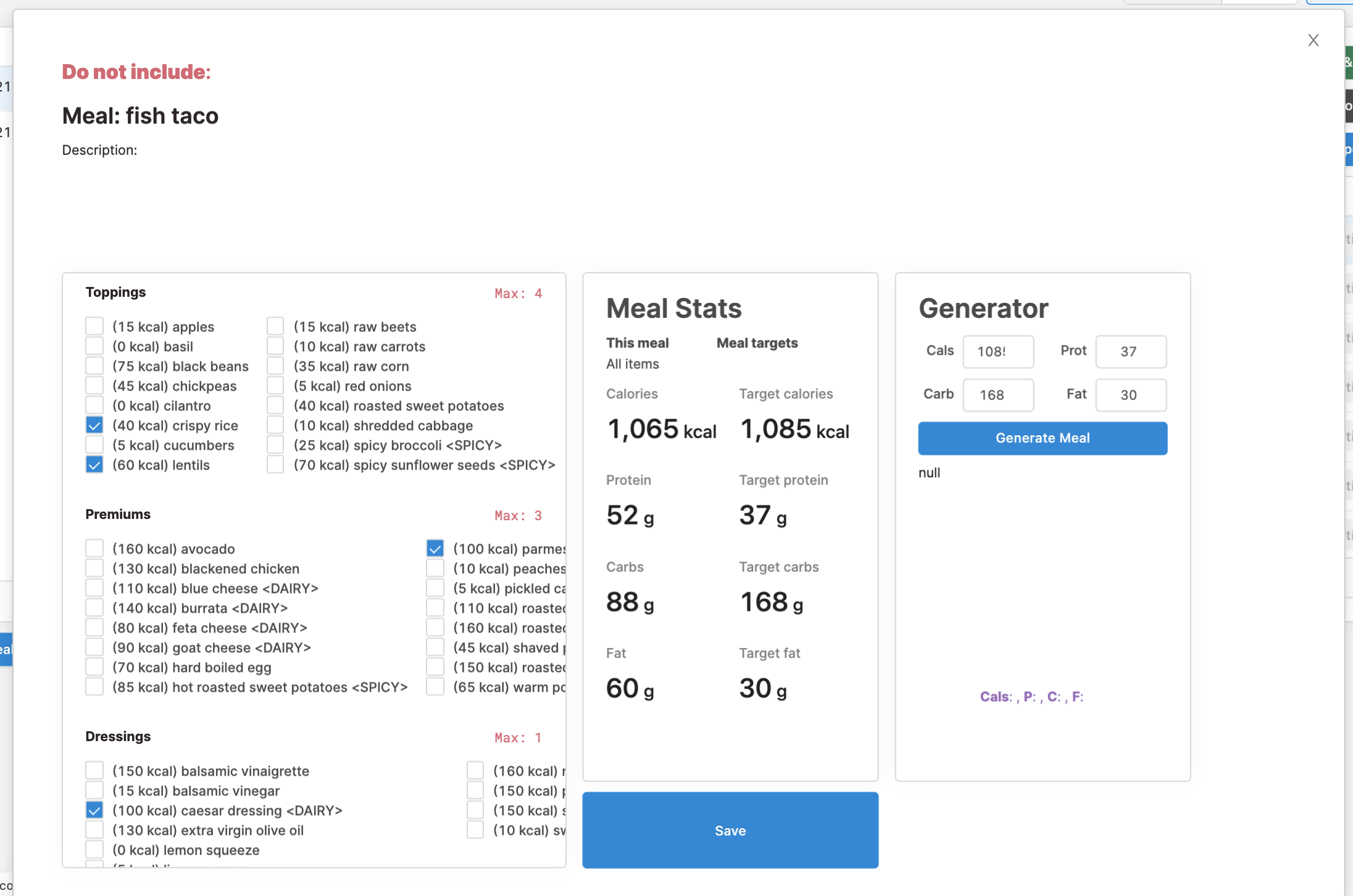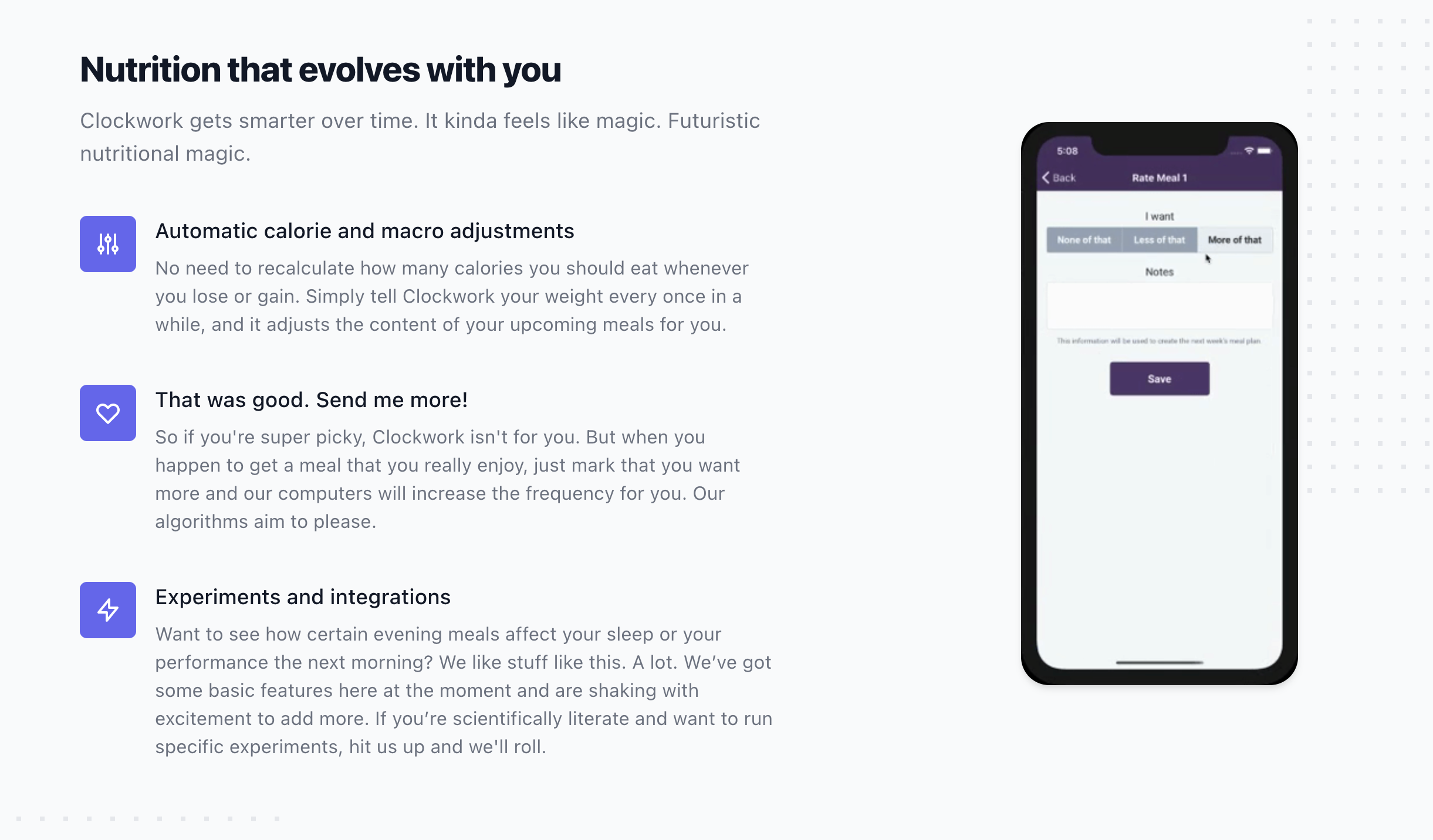“I don’t want to think about it. I don’t want to pay attention to it. I just want it to be handled on time every day, like clockwork.”
“Wait. I got it.”
“What?”
“That’s it. That’s the name. Clockwork Nutrition.”

At Ultraworking, we’re looking to create a complete peak performance platform. We want to help ambitious people do important work.
Not just work itself, but any input that affects personal performance: nutrition, sleep, physical activity, environment, and so on.
Our first direct expansion beyond work is Clockwork Nutrition, a fully-automated meal service which used public nutritional datasets and mainstream meal delivery services to create custom-tailored (calories, macros, etc.) hot meals delivered daily.
Replacing Your Personal Chef and Nutritionist
Clockwork is an complex product based on a simple idea: we replace your (1) nutritionist and your (2) personal chef with algorithms and the delivery services you already use.
During onboarding you give us your age, height, weight, and the body composition you wanted (cut down, bulk up, or stay the same) — and we’d create and order two meals meals every day from a mainstream delivery service.
Over time, as your body composition changes, we’d adjust the macronutrient composition of your meals.
We also do a few fancier things: automated macronutrient cycling, geoshifting meals for travel, correlation with sleep quality, and more.
The Waitlist Exceeds Our Capacity
We want to have an extraordinary customer experience, so we opted for a waitlist model where we’d onboard users as we had capacity.
The waitlist got very long, very quickly with some key endorsements (special thanks to Cam Weise and Ruben Hariss for helping spread the word).



While we were never able to properly crack churn at scale (it turns out that flexibility is a strong revealed preference), a few customers loved Clockwork so much that they’ve subscribed to twice-a-day meal deliveries for multiple years.
The Future of Clockwork
Our current goal with Clockwork is simple - invite the remainder of the waitlist while sustaining the same level of customer service.
Beyond that, well, you’ll just have to wait and see.
Appendix: Clockwork Nutrition Technical Overview
A Team of Many Hats
The technical team for Clockwork Nutrition is myself and our two lead developers, Luka Dover and Saad Zafar.
Saad created the majority of the ordering systems and did some magnificent cost optimizations (and held down a large portion of customer service).
Luka spearheaded the early recon development and algorothmic nutritional composition (in addition to lending his expertise in the science of nutrition and performance).
I’d be remiss to leave out Sebastian Marshall, who’s technical role could perhaps be best described as inventor and architect.
There’s truly somthing to be said about have small elite teams with a meaningful mission.
Clockwork’s Technical Systems
There were three primary systems behind Clockwork — human ops (onboarding, customer support, etc.), our backend nutriton and ordering tech, and our user-facing applciations. I’ll skip the human ops for this post and focus on the backend systems and user-facing applications.
Backend: Nutritonal Tech
-
Nutrition Database: A database of nutritional information (e.g., protein, carbs, fat, calories) for meals collected from the official sources on the internet. We used Firebase (Firestore) for this. Meal items were stored in a special format describing their meal composition
- groups (e.g., bases, protein, sides)
- options (i.e., ingredients like chicken, steak…),
- constraints of each group (e.g., max 2 protein, min 1 side)
-
Nutritional Programming: Our tools for creating the right nutritional program based on user’s stats (BMR, activity level, specific foods they consume consistently (e.g. intra-workout fueling)), training protocol, and goals.
-
Meal Construction:Our tools for constructing meals that hit the targets in the nutritional program. Two primary tools (1) an automatic meal plan builder using a genetic algoritm and (2) a manual tool builder that let us create the meals (we used Retool for this).

Backend: Ordering Tech
For ordering, we primarily relied on Airtable structured around three primary tables: Users, Meals, and Orders.
-
The “Users” table encompassed all Clockwork users. This data would be populated automatically when a user completed the Delivery Survey using Google Forms.
-
The “Meals” table kept records of every meal designated for users and provided meal descriptions essential for order placements.
-
The “Orders” table listed all orders made for Clockwork users. Multiple meals might correspond to a single order, but each order was uniquely crafted for a particular user. This table aggregated meal data from the Meals table, especially if several meals were integrated into one order. Furthermore, tracking details and costs were logged here as well.
If a scheduled meal was unavailabile, our team could select the user, date, and meal time in question and a custom tool we built to suggest alternate meals, ranked based by nutritional target alignment. Choosing an alternative would auto-update the Meals table in AirTable, reflecting the changes in linked orders.
User-facing Apps: Electron and Mobile
We developed two main user interfaces: the Clockwork Nutrition module in Headquarters and the Clockwork Nutrition mobile app (iOS and Android).

The apps had a number of features. Here are a few of the main ones:
-
Meal-rating: This is the core of personalizing meal preferences. By using ratings like “More of that,” “Less of that,” and “None of that,” the system could auto-adjust with the Meal Plan Generator or provide feedback for manual adjustments by meal creators.
-
Weight logging: A dynamic feature that adjusted the nutritional program based on user’s weight patterns. For instance, if a user wasn’t shedding weight, the system would increase their caloric deficit. Moreover, the seamless integration with FitBit and Google Fit allowed automatic weight-syncing when connected through Headquarters.
-
Nutritional profile: This contained foundational data to compute the Basal Metabolic Rate (BMR), such as age, gender, weight, and height. Users could also input their weight goals, which the system would then use to tailor the nutritional program. Importantly, this profile was mutable, accommodating changes any time.
-
Geoshifting: When users went on a business trip or vacation, they could have their meals sent to their new location without disruption. No need to go off diet just because you’re moving to a new place.
